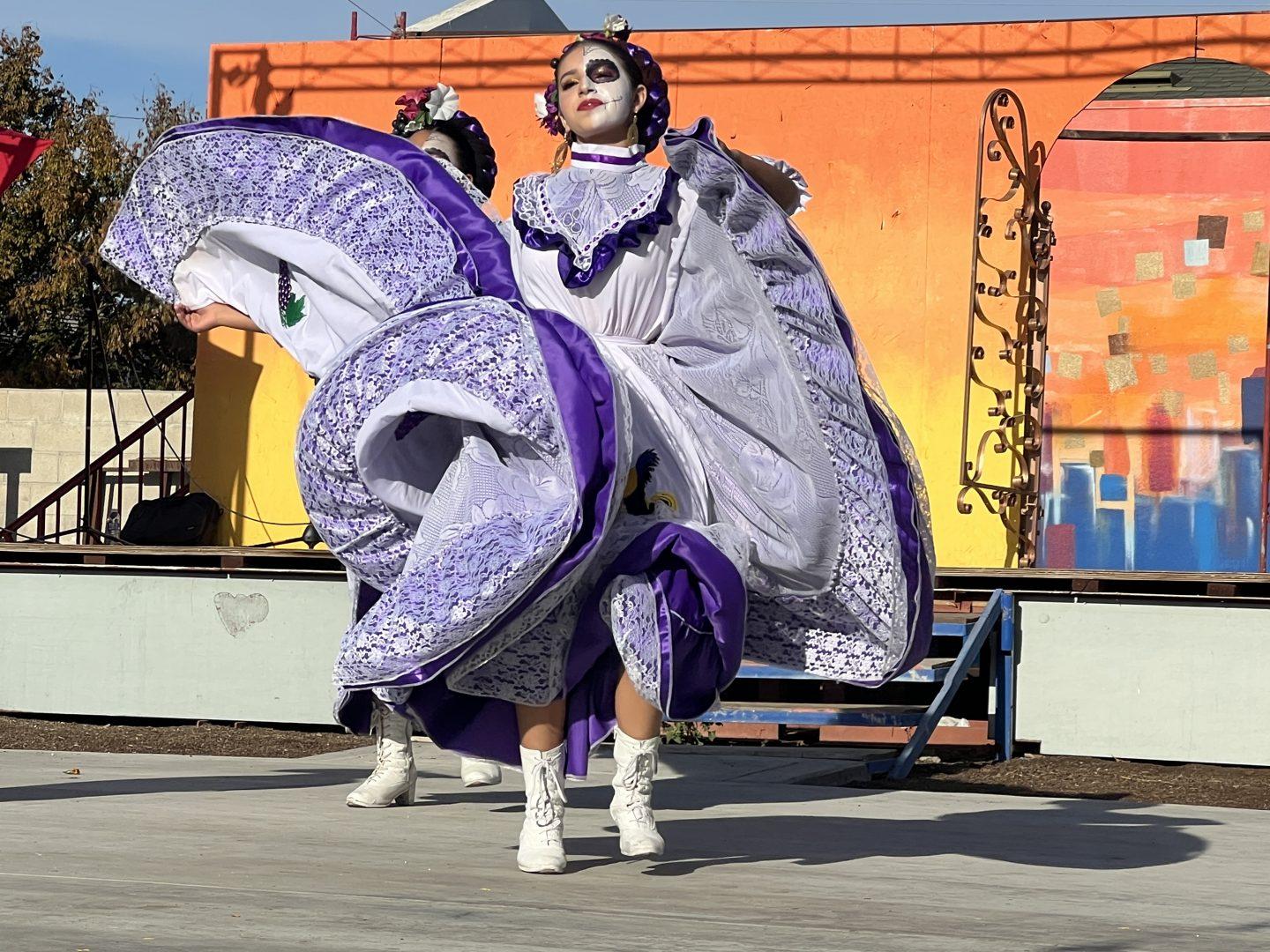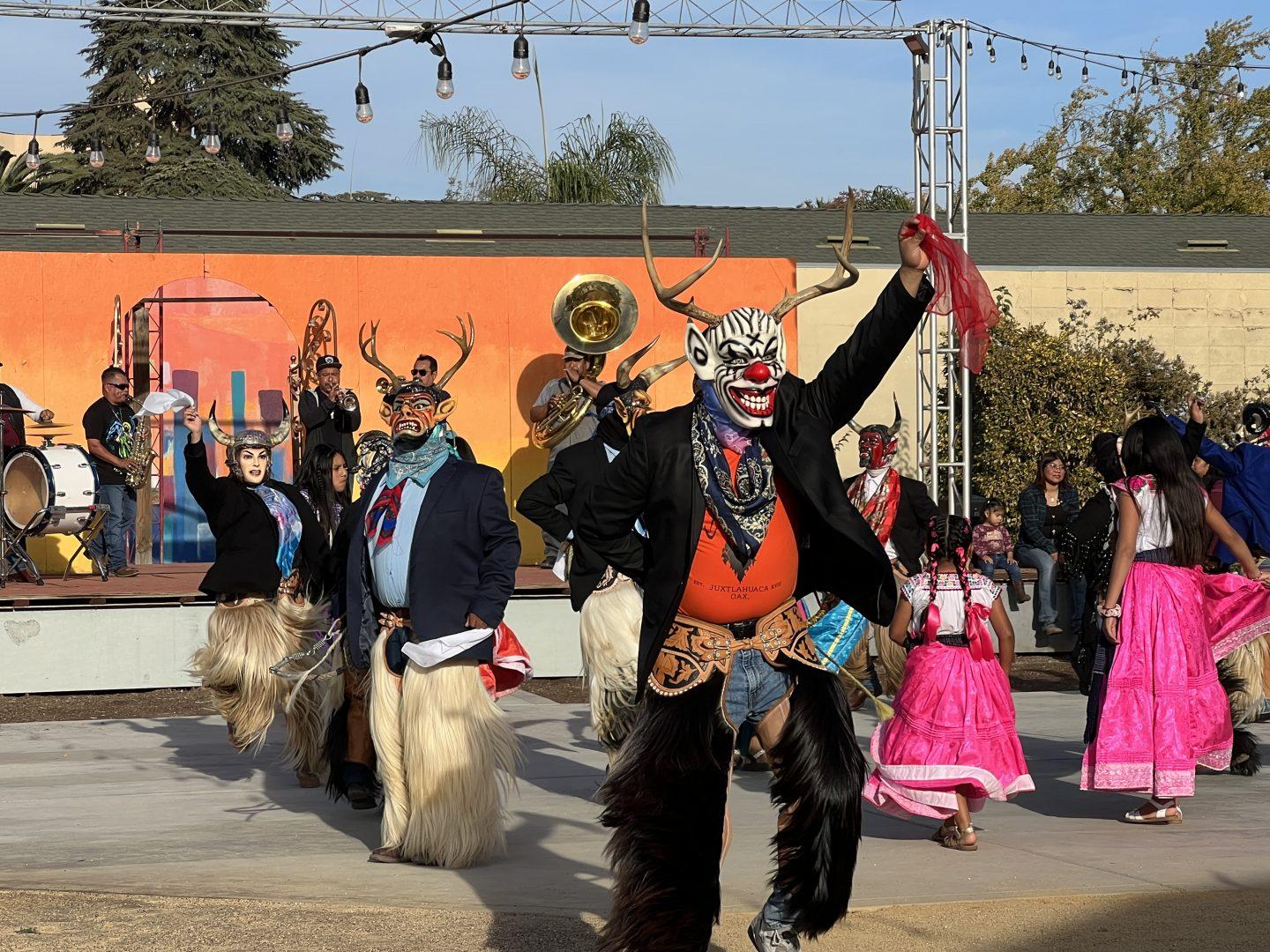Arte Américas’ Cala Gala event on Oct. 29 celebrated the cultural arts center’s annual Dia de los Muertos, or the Day of the Dead, exhibition curated by Leticia and Claudia Martinez, two artists from Visalia.
The event was part of Arte Américas’ ongoing exhibit which runs through Dec. 1.
Arte Américas has held a Dia de los Muertos event since its founding 35 years ago. This year’s exhibit placed an emphasis on nostalgia and home, named “La Añoranza,” or “The Longing.” It continued the tradition with food trucks, art vendors and cultural dances.
Although they now live in the Valley, Claudia and Leticia were born in Puebla, which is in east-central Mexico. In homage to the annual Dia de los Muertos celebration that would happen in Puebla, they replicated the event in their artwork.
The exhibit is adorned with marigolds, believed to attract the souls with their bright colors and strong fragrance, and decorated altars to honor those who have physically departed. Artist volunteers, who were part of Arte Américas’ volunteer networks, painted art on the exhibit walls. Two of the volunteer artists were Fresno State student Idaly Rodriguez and alumna Stephani Ayon.
Saraà Ramos, the program director, celebrated her one-year anniversary with Arte Américas during the event and emphasized that this year’s exhibit brings people together to both celebrate and mourn.
“This is a place where we can all commemorate those who have departed — our families, [and] our loved ones, as well as our ancestors and even strangers,” Ramos said. “With the recent happenings of mass shootings and very traumatic immigration experiences, it’s really a space to commemorate all of that.”
On display near the exhibit was a large pink area covering a section of the floor displaying the words Dia de los Muertos. While it looks like a regular carpet, it is actually made of sand wood.
Tapetes, which is Spanish for rugs, are made out of sand and finely filtered sawdust. They are traditionally used in southern Mexico to welcome the souls of the dead.
Among those who came out for the Cala Gala was Lydia Serrano, a Fresno State alumna with a master’s in criminology.
“I’ve become more interested in Dia de los Muertos since both of my parents have passed on now, and as a tribute to them we have an altar in our home,” Serrano said. “I enjoy coming and seeing the exhibit and seeing different people’s interpretations of how they honor their loved ones.”
Serrano, who has been coming to the annual Dia de los Muertos events at Arte Américas for 10 years, said she wishes more people would come to experience all of the beauty the exhibits have to offer.
“Every year, it’s different. I enjoy the colorful altars, and I like coming to the Cala Gala because of the extra stuff, like the music and the vendors,” Serrano said.
Food and art vendors in the Plaza Paz gave those in attendance the chance to eat, shop and hold space to celebrate life.
Adults and kids gathered around the plaza to take pictures with Letty “La Catrina,” who is one of the strongest and most recognizable symbols of the Day of the Dead.

La Catrina is a tall female skeleton on stilts who wears an elaborate hat with feathers. She is meant to embody the message of Day of the Dead celebrations, which is that death is something to celebrate rather than fear or mourn.
Curator Leticia Valencia, who has previously designed and created a different dress for every Cala Gala event she’s attended, has been honoring La Catrina for over three decades with her work, according to Ramos.
“She really embodies the essence of La Catrina. Her roots of Dia de los Muertos go back to pre-Hispanic times, so she knows what it’s like to celebrate before colonization,” Ramos said.
Local vendor Jessica Castro is the owner of Casita Bilingüe Decor Co., where she sells handmade Spanish-English bilingual home decor centered around sayings that her parents and grandparents used in her home.
“For me, it’s about representation because when you go to Hobby Lobby, you don’t see Spanish signs or bilingual signs. That’s why I started my business,” Castro said.
Castro said she plans to continue to come back as a vendor at Cala Gala each year due to the overwhelming support she has received since her debut the year prior.
After Castro’s son passed away in 2020, she began to celebrate Dia de los Muertos as a way for her and her daughters to find healing.
“It’s a way for us to celebrate his memory and talk about stories of him, because I really don’t want them to forget how he was and who he was and all of the different things we miss about him,” Castro said.
Another vendor, Karina Orocio, owns Quetzalli Shop, which she named after her daughter, and sells handmade arts and crafts from Mexico.
Orocio sources her products from women in Mexico who are survivors of domestic violence or have been sexually exploited.
“I like to support them because I know how important it is for them to be able to make some income and I am able to help them by selling these items,” Orocio said.
For Orocio, Cala Gala is important because it’s a way for her to celebrate life and to remember her loved ones.
“My grandma just passed away three weeks ago, and it’s a little more meaningful to me this year because it hit me really hard,” Orocio said. “Even though she’s gone and not here physically, in spirit she will always be with me in my heart… Dia de los Muertos is a very important cultural day for us Mexicans, and hopefully, we can continue to celebrate this tradition.”
Part of the yearly tradition is Baile Folklórico or folklorico dance.
This year’s Baile Folklórico featured performances by Abigail Cabezas, Rose and Juan Nuno and Vanessa Sapien from Ballet Folklorico y Marimba de Fresno (BFMF), who danced in traditional cultural clothing to pay tribute through movement and music.
Ariana Salinas choreographed this year’s dance, which took the dancers a year to learn.
As locals enjoyed the art, food and cultural festivities, the theme of celebration was shown through smiles and people embracing one another.
Mexican culture celebrates what most fear through Dia de los Muertos and is centered around memories of their loved ones to pass on from generation to generation.




